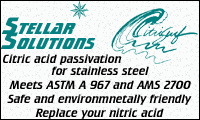
Curated with aloha by
Ted Mooney, P.E. RET

The authoritative public forum
for Metal Finishing 1989-2025

-----
The Advantage of Passivation, Why Do We Need to Passivate and How Is It Done?
I am working in petrochemical plant and some cooling water passivation work is now needed. I would like some information on why should we do it and the how is usually done
Thank you,
employed - Saudi
January 13, 2008
January 21, 2008
Tom,
I would start with reviewing
AMS2700 and/or SAE
AMSQQP35
[canceled]. After reviewing these documents you may be able to come back with more specific questions relating to your particular situation.
Aerospace - Yeovil, Somerset, UK
February 11, 2008
I assume you mean passivation of stainless steel.
In a nutshell, it is removing the free iron from the surface to enable the remaining chromium to form a protective, passive, chrome oxide layer, thereby resisting corrosion. This is achieved with nitric acid or, increasingly, citric acid based formulations.

Ray Kremer
Stellar Solutions, Inc.
McHenry, Illinois

Q, A, or Comment on THIS thread -or- Start a NEW Thread